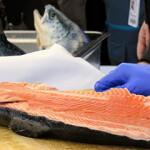Scottish salmon farmers save historic dam to help wild salmon stocks

Scottish salmon farmers have saved a historic dam in order to maintain a wild salmon run.
Fincastle Dam, located in West Harris, on the Western Isles of Scotland, is a Victorian-era structure built in the 1890s. The dam forms nearly the entire western bake of Loch Fincastle, and forms an integral part of the landscape and helps support wild salmon spawning grounds in the Laxdale River.
Roughly a year ago, the dam sprung a leak and was on the brink of complete collapse, putting the local salmon population at risk. Now, thanks to the Wild Salmonid Fund – which addresses the impact of habitat loss and rising river temperatures on wild salmon – the dam is on track to be saved.
The GBP 1.5 million (USD 1.7 million, EUR 1.7 million) fund is supported by aquaculture trade body Salmon Scotland, and is managed by independent charity Foundation Scotland.
In May 2022, the Fincastle Dam project was awarded GBP 35,000 (USD 38,600, EUR 39,600) by a decision-making panel made up of experts in wild fisheries as well as aquaculture. Today, the structure has a steel spine down its center which has enhanced the integrity of its wall and will support wild fisheries for future generations.
“The Wild Salmonid Support Fund offers a real opportunity for struggling fisheries in Scotland to protect and improve their precious wild salmon ecosystems and build community ties in the process,” the West Harris Trust and Borve Lodge Estate said in a joint statment.
Salmon Scotland Chief Executive Tavish Scott said the success of the restoration project was will ensure the dam is preserved for generations to come.
“Salmon farmers have a shared desire to address the decades-long decline in wild salmon populations, caused by climate change and deforestation. By supporting community-led projects to restore our rivers and habitats we are playing our part in reversing the global decline in wild salmon numbers,” he said.
The salmon sector has been asking for greater control over community investments made via fees paid by the industry. Salmon Scotland has called for a greater share of the GBP 20 million (USD 22.1 million, EUR 22.6 million) that it pays to Scottish regulators, asking it be reinvested in rural communities with a focus on new affordable housing – instead of the government redistributing it across the whole country.
“Salmon farms are proud to be making this financial contribution, which shows what can be achieved when the money we create is reinvested in local communities and not sent to quango coffers in Edinburgh,” Scott said.
Scott said a shortage of housing in island and highland communities is keeping people out of the housing market and causing problems for industries in the area that are facing skill shortages and depopulation.
“There is an opportunity in the program for government for ministers to ensure the millions sent to quangos are put to better use by building affordable housing, ensuring the economic success generated by Scotland’s biggest food export is enjoyed by the communities where we operate,” Scott said.
Scottish salmon accounts for more than GBP 500 million (USD 551.8 million, EUR 565.5 million) in fish sales across the U.K. retail market annually, representing around 48 percent of the country’s overall fish market. The product is also the United Kingdom’s top fresh food export, with international sales in the first half of 2022 valued at GBP 280 million (USD 309 million, EUR 316.7 million).
Photo courtesy of the Borve Lodge Estate






Share